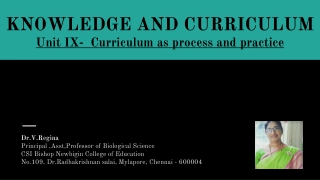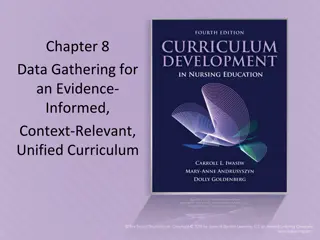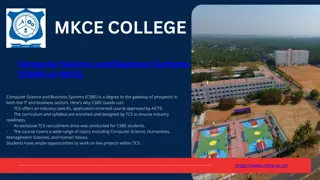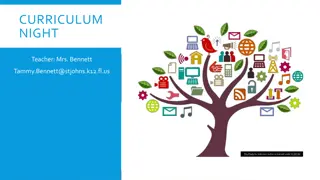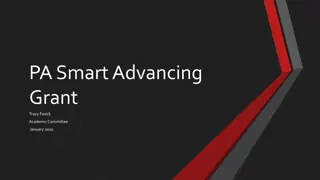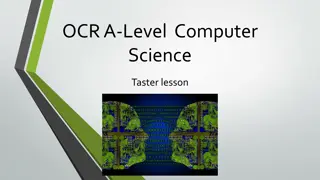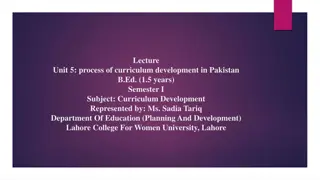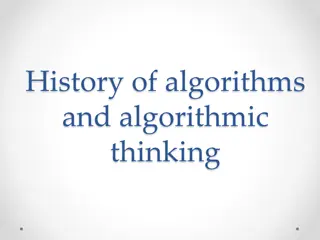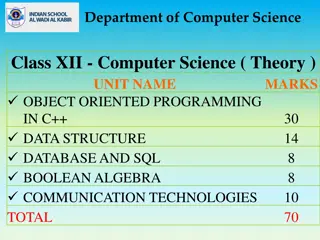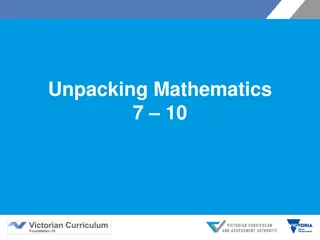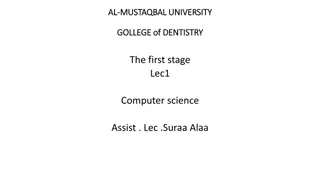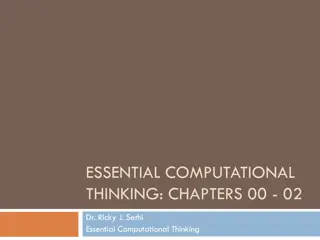Exciting A-Level Computer Science Curriculum
Dive into the dynamic world of A-Level Computer Science, covering contemporary processors, software methodologies, algorithms, network security, ethical issues, computational thinking, programming projects, and more. Explore practical applications through independent coding projects and enhance your skills in software development, problem-solving, and computational thinking. Get ready to embark on an engaging journey that combines theory with hands-on programming experiences.
Download Presentation

Please find below an Image/Link to download the presentation.
The content on the website is provided AS IS for your information and personal use only. It may not be sold, licensed, or shared on other websites without obtaining consent from the author.If you encounter any issues during the download, it is possible that the publisher has removed the file from their server.
You are allowed to download the files provided on this website for personal or commercial use, subject to the condition that they are used lawfully. All files are the property of their respective owners.
The content on the website is provided AS IS for your information and personal use only. It may not be sold, licensed, or shared on other websites without obtaining consent from the author.
E N D
Presentation Transcript
A-Level Computer Science Be Happy, Be Ambitious, Make a Difference
Do Now What do you think A-level computer science will cover?
Component 1 Computer Systems The characteristics of contemporary processors, input, output and storage devices. Types of software (operating systems) and the different methodologies used to develop software. Data exchange, database concepts, introduction to SQL. Networks, network security and threats, HTML and web technologies. Data types, Boolean algebra, data structures and algorithms (analysis and design of algorithms). Legal, moral, cultural and ethical issues. Written exam paper (2hrs 30mins) worth 40% of total A Level
Component 2 Algorithms and programming What is meant by computational thinking (thinking abstractly, thinking ahead, thinking procedurally, etc.) Problem solving and programming how computers and programs can be used to solve problems. Algorithms and how they can be used to describe and solve problems. Written exam paper (2 hrs 30mins) worth 40% of total A Level.
Component 3 Programming project Students are expected to apply the principles of computational thinking to a practical coding programming project. The project is designed to be independently chosen by the student and provides them with the flexibility to investigate projects within the diverse field of computer science. Students are expected to analyse, design, develop, test, evaluate and document a program written in a suitable programming language. Non-exam assessment (NEA) worth 20% of total A Level.
Big Question How do you think like a computer scientist?
Transition lesson Let s use some basic ideas in computer science to create a python program which generates insults. Skills we will cover: Creating and using a .csv file Opening and reading from a file in Python Using lists in Python Choosing random elements Reusable Functions Formatting strings
What will you need Python installed Additional resource files for this lesson (actually optional, but will speed everything up!)
1. Generating insults Go here are find the document on Shakespearean insults: https://www.theatrefolk.com/free-resources/shakespeare (Or you can find the pdf in the pack with the other lesson resources) To find out a little about how we are going to be creating some lovely sounding insults to throw at people.
2. What is a CSV? CSV stands for comma separated variables and is a standard file format which you may not have seen before but is useful when dealing with large sets of data.
3. Creating a CSV You can type out a .csv by hand using a text editor, but spreadsheet software like Excel will also create .csv files for you quickly and easily.
4. Opening and reading files File handling is part of the GCSE computer science course, you can type the code out yourself, or use the 04 reading files.py file as a starting point.
5. Creating and using lists Lists are a standard data structure in Python, we won t look at them in detail, you just need to know how to make an empty list, and then add stuff to it. The template file is called 05 creating lists.py
6. Picking randomly from a list We want a different insult every time, so let s pick one from the list at random. Python can t do this by default, so we will use a library called random to help us out. Template: 06 random choice.py
7. Formatting your output Finally, it would help to make the output easy to read, with spaces and stuff! Formatting strings is a big complex topic, so we ll just look at a very simple approach here. Template: 07 formatting.py
Possible extensions: Add some more insults of your own to the list. Make the output prettier. Make the program reusable (it could ask if you want another insult and only exit if you say no). Create a GUI for the program (there are many, many ways to do this!)


